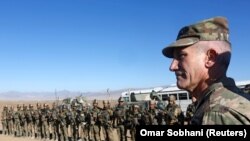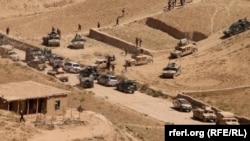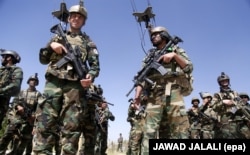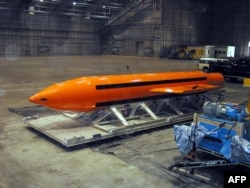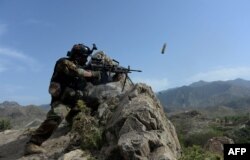Russian Foreign Minister Sergey Lavrov emphasized the Islamic State’s presence in South Asia and downplayed Western efforts at a February 20 press conference that followed talks with his Pakistani counterpart Khawaja Muhammad Asif in Moscow.
“According to our data, the IS presence in northern and eastern Afghanistan is rather serious, there are already thousands of gunmen. This increases the risk of the terrorists’ penetration to Central Asia and it is not that difficult to get to Russia,” Lavrov told reporters.
He also said Russia has “serious suspicions” about the measures the U.S. and NATO are taking to address the threat. He said Moscow is seeking answers from the U.S. about “flights of unmarked helicopters” to insurgent areas, implying Washington may be supporting IS.
Pakistan’s Foreign Minister Asif echoed the concerns, saying neither the U.S. nor Afghanistan recognize the problem.
“But there is absolutely no acknowledgment, real acknowledgement, by Kabul and Washington of such a large presence of Daesh (IS) or the proliferation of Daesh in Afghanistan. … They are a threat to Central Asia, Pakistan, China and ultimately to Russian Federation,” Asif said.
The two officials agreed to create an anti-terror military cooperation commission to tackle the threat.
Russia and Pakistan have legitimate concerns about the threat of terrorism, but their deteriorating relations with Washington have long fueled mutual accusations. U.S.-Russian ties worsened significantly after Moscow intervened in Ukraine, annexed Crimea, and allegedly interfered in the 2016 U.S. presidential election. And U.S.-Pakistani relations soured recently after the U.S. suspended military aid to Pakistan and accused it of supporting terrorist groups and not doing enough to induce the Taliban to seek peace with Kabul.
Joseph Trevithick, a former fellow at GlobalSecurity.org, says there is no evidence supporting Russia’s frequent allegations that the U.S. has supported terrorists from Afghanistan to the Middle East, calling the claims “deliberate information warfare tactics” against the U.S.
“The use of these questionable allegations offers the Russian government an easy, low-risk, and relatively low-cost way to obfuscate what are often complicated situations to be with and do so in such a way that isn't easy to for foreign governments to quickly counter,” he wrote, adding that it often falls on Washington to deny the claims rather than for Moscow to substantiate them.
In this case, however, no such U.S. denial appears necessary. The U.S., NATO, and Afghan forces have not only acknowledged the IS operations but also are aggressively targeting the group. Even so, Islamic State fighters are reportedly fleeing Iraq and Syria and heading to Afghanistan and IS is actively recruiting fighters there.
Responding to Russia’s accusations, Commander of U.S. forces in Afghanistan Gen. John Nicholson said on February 24 that Moscow’s estimates of IS militants in the country are “grossly exaggerated” and that the group has only approximately 1,500 fighters.
“We have cut their numbers in half over the last two years. We have killed their ‘amirs' (chiefs), we have reduced their territory, again, we have driven their fighters out of parts of the country,” Nicholson added.
U.S. President Donald Trump, in August 2017 remarks on the new U.S. strategy for South Asia and Afghanistan, identified the U.S. military’s priorities: “Our troops will fight to win. We will fight to win. From now on, victory will have a clear definition: attacking our enemies, obliterating ISIS, crushing al-Qaeda, preventing the Taliban from taking over Afghanistan, and stopping mass terror attacks against America before they emerge.”
Last November, Trump also said that the U.S. would “hit [ISIS] like you folks won’t believe.” The remark came in the wake of the latest IS-inspired attack, which killed eight people in New York.
In 2017, the U.S.-led coalition increased the number of airstrikes in Afghanistan to unprecedented levels as well as nearly doubled the number of troops deployed in the country.
“One in five of those strikes is against ISIS-K (the Islamic State in Khorasan), despite it controlling only slivers of mountainous territory,” The Washington Post wrote in July about the coalition’s anti-terrorism campaign.
In April 2017, U.S. forces used the “Mother of All Bombs,” or MOAB, the largest non-nuclear device in its possession, to target an IS tunnel in the Achin district of Afghanistan’s Nangarhar province, killing dozens of IS fighters.
That same month, the coalition dropped more than 5,000 bombs on IS positions, “the most of any month in the three-year campaign to defeat ISIS,” said the U.S. Air Forces Central Command.
According to VOA reporting in November 2017, the U.S. estimated that the group’s ranks had shrunk from 3,000 to 600 fighters thanks to the sustained, joint counter-terrorism campaign.
Still, the coalition is concerned that Nangarhar province could become an IS safe haven now that anti-IS operations in Syria and Iraq are winding down, despite the coalition using the freed-up counter-terrorism resources in Afghanistan, where they are allegedly making impact already.
Afghanistan’s Ambassador to the U.S. Hamdullah Mohib struck a cautious tone, urging swift action against insurgents: “The brutality will continue to increase, which is why we need to address it so rapidly. The more time it takes, the more radical some of these groups become…”
Yet, concerns that the U.S.-led coalition has lost ground have mounted in recent months, as the war continues 17 years after the U.S. began its military operation in Afghanistan. In its latest report, Special Inspector General for Afghanistan Reconstruction found that insurgents, predominantly the Taliban, controlled 56 percent of the Afghan territory, the worst figures yet for the coalition battling various terrorist-related groups and insurgents.
The report came after the Pentagon initially refused to release unclassified data that would indicate the extent of Afghan government control of its own territory. The Pentagon eventually released the data, blaming the delay on “human labelling error” and saying “it was NOT the intent...to withhold or classify information which was available in prior reports.”




